Types of axes and their characteristics
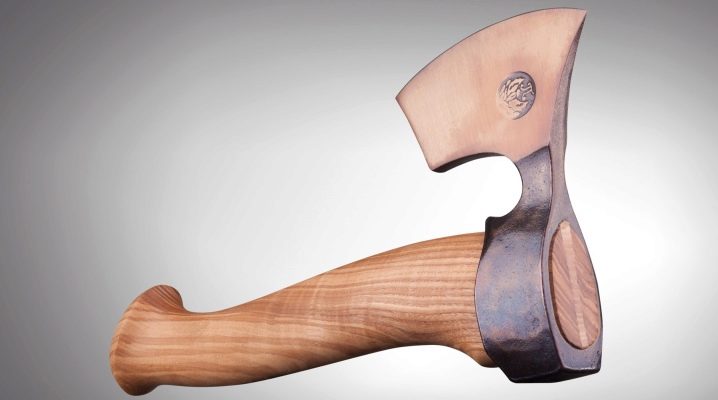
An ax is a device that has been used since ancient times. For a long time, this tool was the main tool of labor and protection in Canada, America, as well as in African countries and, of course, in Russia. Today, the industry offers a wide range of axes of various shapes and sizes, each of which has its own functional purpose.
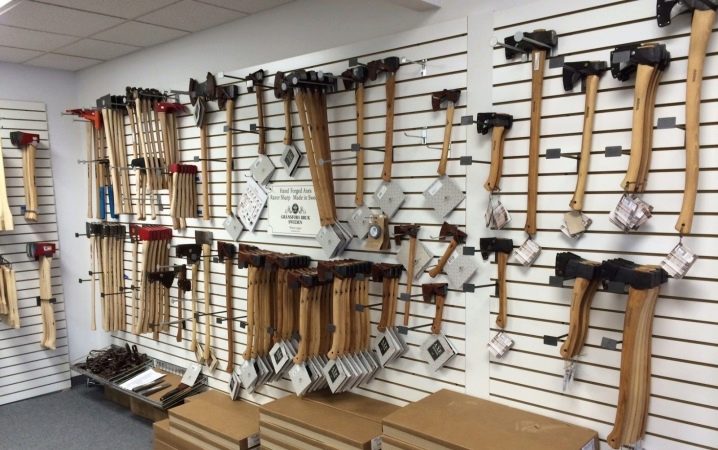
Types of forms
Ancient axes had a beard-shaped butt type, that is, the front part of the blade was expanded from below, and a recess was formed in the opposite part. Such products were quite popular in European countries, where they were widely used both as an economic tool and as a military weapon. Modern axes are usually straight or rounded. The former are used for rough timber, and the latter are used for wood processing. The handles of such tools are made from the hardest species - birch, maple, as well as hornbeam or ash; the materials used should not have any cracks, or knots, or any kind of rot.
The most common type of ax is a carpenter's ax, which has been known since Soviet times.
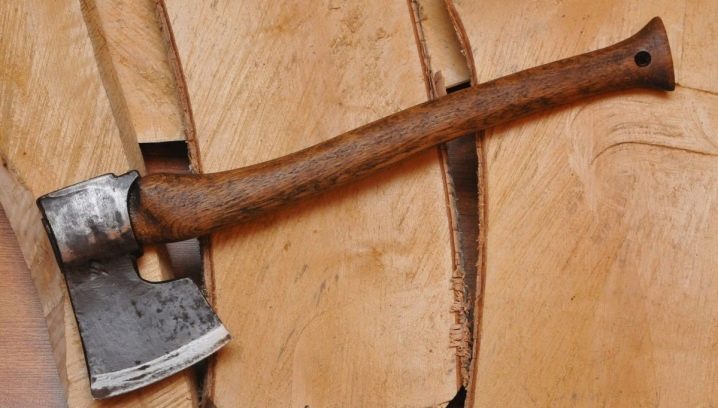
Its blade is shaped so that it is most convenient to work with various pieces of wood and small logs. However, in a wild forest, such an ax is not suitable - it is quite difficult for them to cut a tree trunk or a large branch, which is why lighter axes were created, the blade of which has a slightly more rounded shape. Finnish models are most in demand: their blade is rounded on one side, and on the other, it has a recess. With this device, you can not only cut wood, but also chop wood, which is very important in taiga conditions or a long hike in any other area.
It is noteworthy that rounded blades usually have a very interesting sharpening, thanks to which they become truly multifunctional.
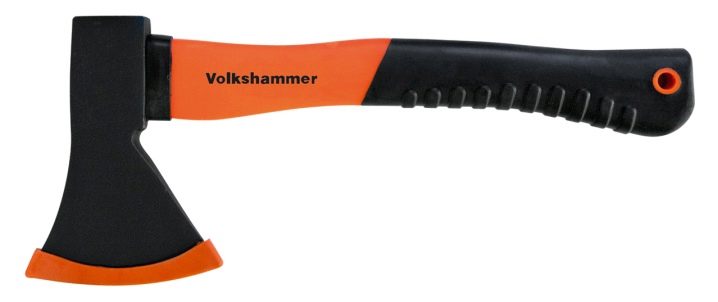
Another type of ax is called taiga; the blade of these tools is used to cut hard wood. The shape of the blade, like that of the Finnish, is rounded, but, in addition, the blade is located at a rather sharp angle in relation to the ax handle - this makes the blows much more effective, since the upper edge of the butt is first of all pierced into the tree. The instrument of the "Deer" brand has a very similar structure, the shape of which is almost identical, but the mass is much less.
The main varieties and their purpose
Now some historical facts. Mankind has invented axes since ancient times. However, the first tools were awkward, extremely heavy and short-lived. People could not do without them, since they had to build housing, cut down tools and hunt wild animals. And wild animals had to be driven away from prey manually. The tool quickly broke down, and a new one had to be made. In the Neolithic era, they learned to grind its surface, and after a few millennia they began to make axes from copper.
Only when iron was discovered did a certain prototype of the modern ax appear - metal with a wooden handle.
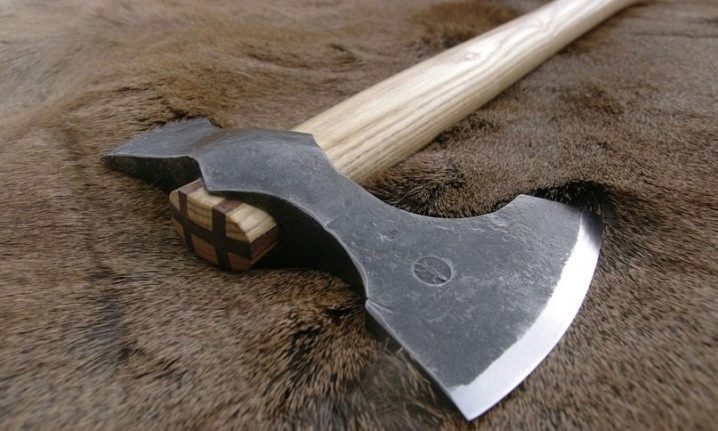
The main part of such a device was a chopper made of iron, which was mounted on a well-hewn club. Over time, the axes have been divided according to their functional purpose.The heaviest models were transformed into powerful military weapons, and due to their high cutting power and low cost, they became the main weapon of the militia. Lighter models began to be used for economic purposes, and we will dwell on them in a little more detail.
Before talking about what types of axes exist, it is necessary to note the main parameters that distinguish them from each other, namely:
- mass of the tool;
- blade type;
- the shape and quality of the hatchet;
- nozzle method.
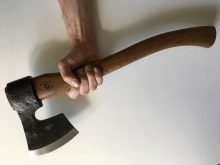
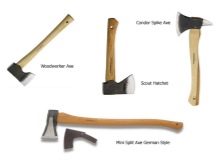
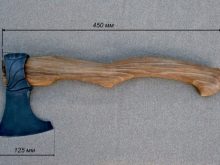
Let's start with the main thing - weight. The smallest tool threshold corresponds to 900 g. Of course, there are axes that weigh less, but their functionality is incomprehensible - in most cases these are not axes, but simply tourist hatchets, which can be used to cut thin branches and sharpen stakes under a tent. As a rule, they are optimal for day trips, but not suitable for long hikes. The weight of a reliable ax should vary from 900 to 1600 g. In this case, it is possible to chop off medium-sized branches, and it is much easier to wield a tool of this mass, since the lumberjack feels how it is "fixed" in his hand. Similar axes are used in low-rise residential construction and decoration.
If you need to cut down large trees and chop large-sized firewood, then you should give preference to models weighing more than 2.3 kg - usually such blades are supplemented with an elongated hatchet, due to which the impact power increases.
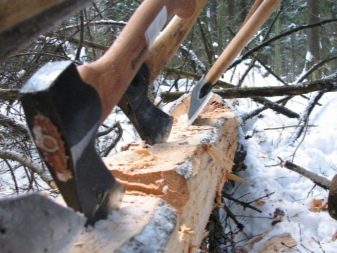
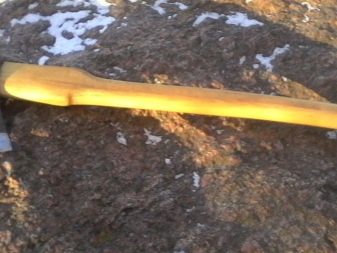
The quality of the steel used is also of fundamental importance, everything is obvious here - the more durable raw materials were used, the longer the ax lasts, in addition, the blade will remain sharpened longer, no chips, cracks and other deformations will appear on it for a long time. A very important part of the ax is considered to be its handle, as well as the way of its attachment. For a high-quality blow, it is better to take a tool with a handle of 50-80 cm, and if the blow is to be point-like, then the choice must be made in favor of models with a shortened hatchet.
Let's dwell on the most popular types of axes.
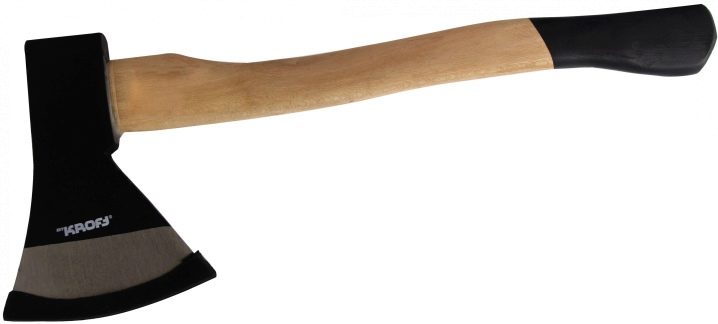
Economic
A utility ax weighs less than a kilogram. It is distinguished by a straight, sharp cutting edge - this tool is used for finishing various wooden blanks and trimming wood. He does not need to cut solid trunks, therefore he does not need a massive butt. These axes are quite sharp, they sharpen almost like a razor.

Plotnitsky
This ax is considered a versatile woodworking tool. It is distinguished by a thin, well-sharpened blade and low weight, thanks to which with the help of such a tool you can perform the widest range of tasks, including cutting grooves and adjusting the parameters of the deck to the required dimensions. Such an ax has the shape of a straight, slightly elongated skirt, the mass is 1200-1300 grams, and the angle of sharpening of the blade is 20-30 degrees.
Angles of 30 degrees are considered more versatile, as they allow you to chop non-solid wood and trim wood parts. A sharper angle of 20 degrees brings it closer to an economic one, and a more obtuse one - to a cleaver.
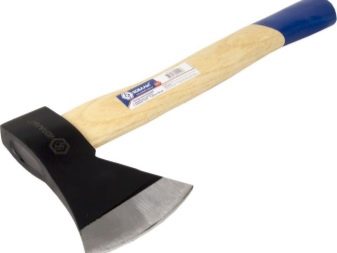
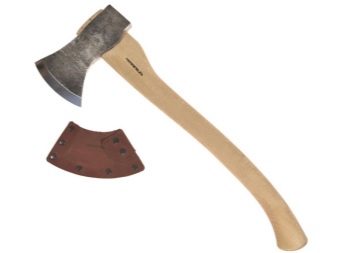
Cleaver
Cleavers are heavy, massive tools with a fairly wide blade; they are needed for splitting logs. The metal part of this gun is distinguished by a rather blunt sharpening, the angle of descents is about 30 degrees. Weight varies from 2 to 3 kg, less often there are instruments weighing 5 kg. The handle is long - from 80 cm and more.
This is due to the peculiarities of the operation of the tool - usually it is clasped with two hands and a high swing is made, in this case, the longer the handle, the stronger the blow.
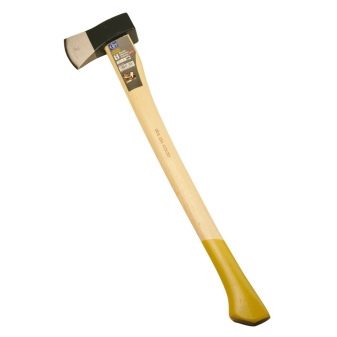
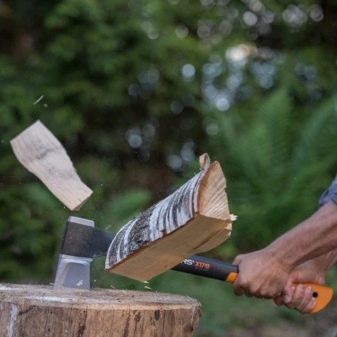
Special models
To solve some problems, separate variants of axes have been created. Let's consider them.
For felling timber
The axes used for felling are usually the longest - the minimum length of the ax is 90 cm, and the weight of the tool reaches 3-3.5 kg.Such a long handle allows for the required swing and impact force parameters, which makes wood harvesting work faster. It should be noted that it is rather difficult to work with such an ax, therefore this occupation is associated with great physical efforts of lumberjacks.
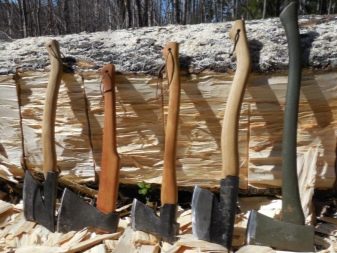
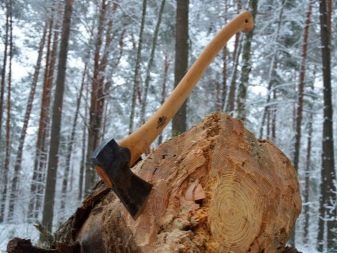
For chopping meat
Axes with a fairly wide and perfectly straight blade are most suitable for chopping meat. Usually, it is sharpened at an angle that prevents the cutting edge from breaking quickly with constant contact with hard, hard bones. The handle of this ax is usually short and extends down to the cutting edge, which is why the device allows very precise cutting blows.
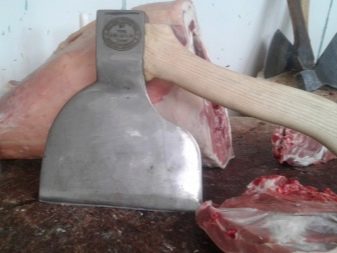
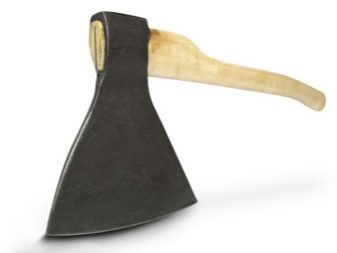
Bilateral
Double-sided axes have found their application in cutting wood blanks, preparing firewood and performing a variety of installation work. The working part of such tools has two blades, in most cases they are made of forged steel using the double heat treatment method. The handle is made of hardwood, most often from hazel.
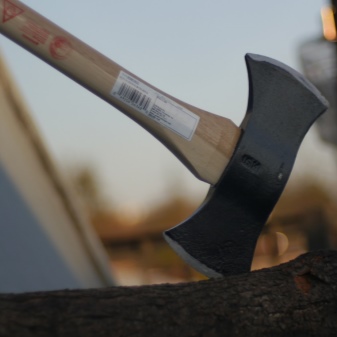
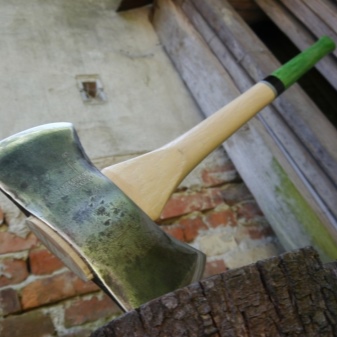
Fireman
Axes are widely used in the work of rescue services, in particular, firefighters use two types of axes - belt and assault. There is a rather sharp peg on the butt of the belt tool, which is necessary for knocking down locks and knocking out double-glazed windows. In addition, this hook can be driven into various surfaces to keep it in the wall or on the roof. Fire axes are usually painted black and red, although yellow inserts are often seen. The handle is covered with rubberized pads that protect the hands from burns. Unlike belt models, assault models are much larger in size, but their shape is very similar.
They are used to knock out heavy doors and destroy any obstacles that might impede evacuation.

The butt often has a hook, or it can be flat, like a sledgehammer. This type of weapon is a mandatory component of any fire shield, which, according to safety regulations, must be located in all public places.
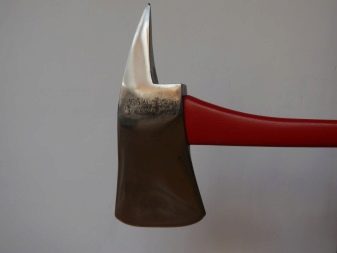
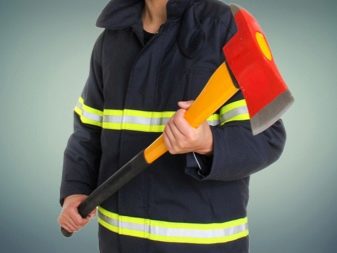
Marching
The tourist ax is called a multitool and has a wide variety of models. Their distinctive feature is their low weight, which is not surprising, given that the instrument has to be dragged on the back for many hours. The handle of such an ax usually becomes a fairly convenient storage for various small things that are needed on any hike. With the help of a tourist ax, various branches are chopped, small trees are dumped and even stones are split to create a hearth. They are usually equipped with covers that protect a person from injury while carrying the instrument.
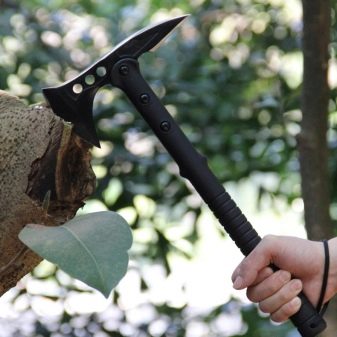

Ice axes are a separate type of tourist hatchets.

They are quite compact and lightweight devices that are necessary for cutting into the ice, if there is an ascent to the snow-capped peaks. This climbing equipment is made double-sided, while one part resembles a well-sharpened hook, and instead of a butt, a sharp blade is made, placed perpendicular to the handle - this structure is optimal for forming a depression in the ice. An army ax can also come in handy on a hike. It is widely used for preparing logs for a hearth, digging trenches, hammering tent pegs, and also as a defense weapon.
For information on how to choose the right ax, see the video below.



































































The comment was sent successfully.